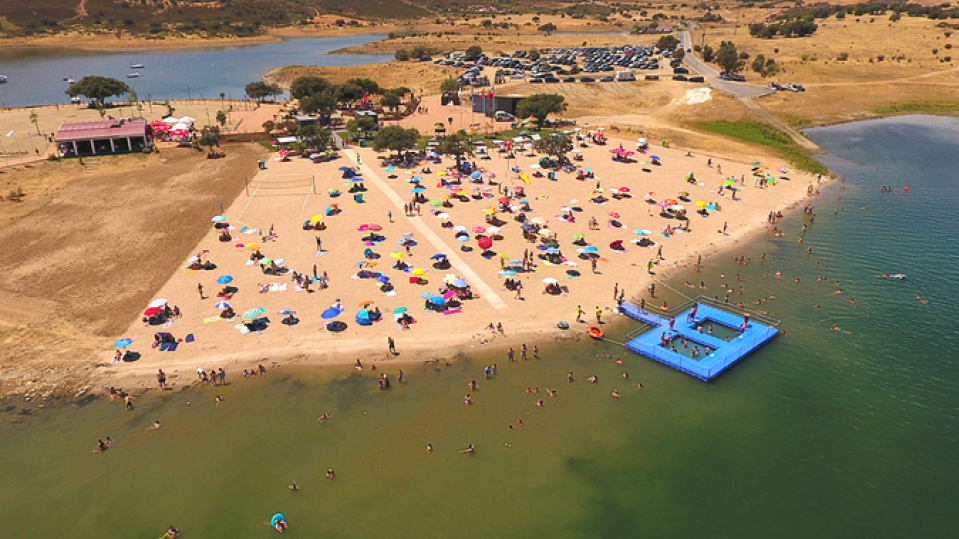The Fortress will enchant you with long cliff walks, natural wonders (sink holes), lovely flowers, majestic seagulls, an elaborate interactive museum and art gallery, a chapel, a lighthouse and all the embellishments of a medieval fort. It was established by Prince ‘Henry the Navigator’ in the 15th century and was crucial to Portugal jump-starting the ‘Age of Discovery’ and then becoming a naval global empire.
To get to Sagres, search for “Sagres Fort, Portugal” on Google Maps. It’s a 40-minute drive from Lagos and there’s plenty of parking at the entrance. There are also buses from Lagos and Lisbon. While there is no food in the Sagres Fort, the adjoining town of Sagres (just a few minutes' drive or a 10 minute walk) has many delightful restaurants, bars and cafes that will reward you after exploring the fort. Plan on spending at least 2 to 3 hours to experience all that the Fort has to offer.
A historical interlude … this Nautical Training Fort played a pivotal role in establishing Portugal as the eminent sea-exploration nation during the 15th century. It served as a hub for pioneering navigators and cartographers who perfected their craft here – the most famous of whom were:
- Gil Eanes 1434 sails around the western coast of Africa
- Bartolomeu Dias 1488, rounded the southern tip of Africa
- Christopher Columbus 1492, discovered America (actually the Bahamas).
- Vasco da Gama 1498, sails to Calicut & Goa
- Pedro Cabral 1500, discovered Brazil
- Ferdinand Magellan 1520, (almost) circumnavigated the globe
The fortress was severely damaged by the earthquake of 1755 and was completely restored only in the 20th century.

Back to exploration of Sagres Fort … enter by long pedestrian entrance (over what was probably a moat) while checking out the flanked buttresses on either side. Get your ticket (10€, less for seniors and students) and enter through the fort’s main doorway. On your left, you will see a gigantic, enigmatic compass rose on the ground (probably to illustrate navigation with the sundial movement of the sun). Building forward left is the museum and forward right is the gift shop (restrooms are on the back side). On the right is ‘Our Lady of Grace’ chapel, where the god fearing explorers beseeched God for protection and prayed that they would find glory (and treasure) on their dangerous voyages. Don’t miss the Portuguese ‘Colonial Pillar’ in front of the chapel that marked Portuguese territories all over the globe (Brazil, Mozambique, Angola, Goa, Macau and Timor). There’s also a US Power Squadron plaque from 1965 acknowledging Prince Henry’s contributions. About a kilometre along the promontory, you will see the working Sagres lighthouse.
The main experience
And now for the main experience … embark on the 3km cliff walkway loop and immerse yourself in the tranquil (but windy) ocean vista panoramic views (20m below). There are frequent sign boards that mention the medieval fort items (drawbridge, ramparts, cannons, fortified walls, pillars), birds, flowers, plants, lighthouse and natural wonders (sink holes). Don’t miss ‘Voz de Mar’ (Voice of the Sea) which is a concrete maze built over a sinkhole. It enables you to hear the waves crashing on the rocks in the sink hole 20m below and the closer you get to the centre, the louder the sound. Often, you will see fisherman patiently casting their long lines in the thrashing waves below. Traverse the paths that once led to the unknown, take a moment to reflect on the bravery of those who dared to venture beyond the known world, charting new territories and forging connections across continents.

Museum
After the cliff walk, relax in the Museum where visitors can delve into the beginnings of the Portuguese Age of Discovery. Get immersed in 15th century Portuguese nobility (standing beside the life size panels), admire the large inter-continental global Portuguese trading routes (large wall maps), interact with the historical video kiosks, listen in a mini-theater to a surround sound charting of ships departing from Lagos/Lisbon and forging Portugal’s global empire. There are also many traditional museum exhibits and displays – the most interesting being the Caravel ship, a lightweight yet sturdy vessel that enabled these remarkable voyages. It was the Ford Model-T of its time, a technological marvel. Pay homage to St Anthony, the patron saint of sailors, who is usually painted holding a ship in the palm of his hand.

However, alongside these feats, it's essential to acknowledge the darker aspects of ancient Portuguese history. The Portuguese infamously initiated the African slave trade, sending captives to sugar plantations in Brazil, the southern New World (USA), and Northern Europe. The museum provides a haunting glimpse of the horrendous conditions endured by slaves during transportation. After all this immersion into the past, feel free to explore the upper floor, where there are usually exhibitions of present-day artists.
Excerpts from Portuguese poet Fernando Pessoa's 1930 poem (plaque at the museum) echoes the indomitable spirit of Sagres that fuelled these discoveries:
God wills, man dreams, the task is born.
The sea to connect, and no longer divide.
He chose you and you went forth unravelling the foam,
And the whole earth was suddenly seen,
Emerging, round, from the deep blue.
Lord, Portugal is yet to be accomplished.
You can be sure that Sagres Fort will leave a lasting impression, beckoning you to return whenever you find yourself again in Portugal.
Benoy DeSouza (and his wife Naressa) recently retired from corporate technology jobs in the USA and now split their time between Raleigh, NC USA (summers) and Lagos (winters). Originally from Goa/India, they acquired a beach apartment in Meia Praia, Lagos and look forward to enjoying the expat lifestyle in the Algarve.














